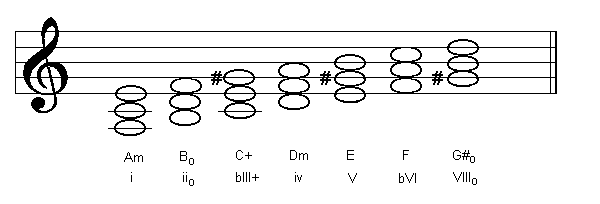
An earlier tutorial introduced the harmonic minor scale. That tutorial took a quick look at the triads derived from that scale - now let's take a look at the other chord types available.
From the triads that we've already looked at, there were a couple of things especially worth noting. Firstly is the fact that the 5th triad of this minor scale is actually a major triad. Secondly the presence of an augmented triad on the 3rd degree. For example, using A harmonic minor:
Now let's try extending those triads to include a seventh degree:
Now that we've got an extra note in each chord there are some more things worth pointing out.
The tonic chord is a type that we haven't seen as yet - a minor chord with a major 7th degree.
The chord on the 2nd degree has been extented from a diminshed triad to a half-diminshed chord (formula 1-b3-b5-b7). This is a chord type that we've seen before, as it occurs in major and natural minor scale harmony. However, take a look at the chord on the seventh degree of the harmonic minor. This is also based on a diminished triad, but instead of adding a b7 degree, the extra note is actually a bb7 - this gives us a dimished (not half-diminshed) chord with the foprmula 1-b3-b5-bb7. Notice the symbol used for this chord, compared to the one used for the half-diminished chord.
The major triad on the 5th degree has been extended to give a dominant 7th type chord. This is a characteristic feature of the harmonic minor scale's harmony.
The augmented triad on the 3rd degree, when extended to include a seventh degree, gives a type of chord that we haven't seen so far - the augmented major 7th chord, with the formula 1-3-#5-7.
The harmony of the harmonic minor is summarised in the following table, again using A harmonic minor as an example:
| Chord | Notes | Formula |
|---|---|---|
| Am(maj7) | A, C, E, G# | 1-b3-b-7 |
| Bø | B, D, F, A | 1-b3-b5-b7 |
| C |
C, E, G#, B | 1-3-#5-7 |
| Dm7 | D, F, A, C | 1-b3-5-b7 |
| E7 | E, G#, B, D | 1-3-5-b7 |
| F |
F, A, C, E | 1-3-5-7 |
| G#o | G#, B, D, F | 1-b3-b5-bb7 |
That was a fairly brief introduction to the 7th chords available in the harmonic minor. The best way to get to familiar with the ideas discussed here is probably for you to take a few harmonic minor scales and harmonise them out in 7th chords. Refer back to the earlier tutorial on constructing 7th chords if you need a refresher on the theory involved in chord construction.
Also, as well as understanding the theory behind all this, it's important to be able to put this into practice, and that means getting comfortable with playing these new types of chords. Good luck.
How useful did you find this tutorial?